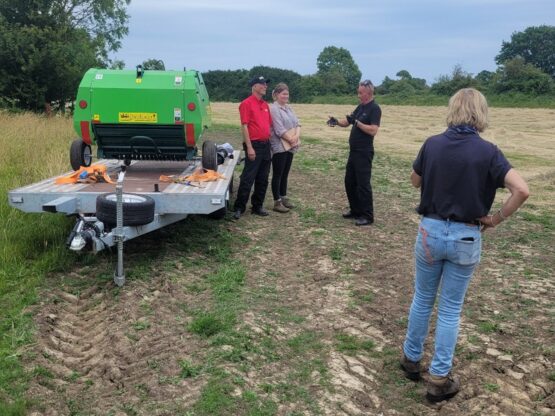Farming in Protected Landscapes Case Study:
Managing field margins and small meadows in the Blyth Valley Cluster

Hall Farm in Wenhaston was awarded £22,078 towards the purchase of haymaking equipment for the Blyth Valley Cluster farms to use for cutting, baling, and carting hay on margins and small meadows.
The trailer allows the midi-baler to be transported between the farms, where it is attached to the farmer’s own tractor. A grant of £614 has also been provided to make a video to share methods of use and best practice.
Objectives
Blyth Valley is a new farmer cluster, planning to take advantage of the
benefits of working together and sharing equipment to save costs. They were
looking to purchase a midi- baler and trailer to share to be used on field margins and meadows which would benefit from traditional management.
Standard-sized hay / straw balers are difficult to use on margins (typically 4-6m wide) and small areas of grassland, resulting in swards being cut but not collected unless this is a stipulation in individual agreements. This kind of management leads to the degradation of these areas as nutrient and organic matter levels increase leading to proliferation of more competitive species such as nettles, rather than the less common species and wildflowers which we are seeking to encourage.
Purchasing a midi-baler and equipment is not a viable option for many farms, therefore demand for a shared midi-baler and equipment to carry out this work is high among cluster members and local community groups such as Wilder Wenhaston, and the Wenhaston Parish Council. Owning the equipment has provided farmers with independence from contractors and flexibility for users, as hired equipment is frequently unavailable when it could be used to best effect.
Managing field margins in this way has many advantages:
- Promoting biodiversity and providing species-rich habitat. This is particularly important in the farmland adjoining the Dew’s Pond SSSI, but encouraging pollinating insects is vital for farming and the environment across the Suffolk & Essex Coast & Heaths National Landscapea nd more widely.
- Field margins sequester more carbon than farmed land. Working together as a group of farms is improving the understanding of this and other solutions for climate change more generally too, helping the Blyth Valley Cluster farmers work towards carbon net zero aims.
- Promoting good soil structure and contributing to slowing flow of water into adjacent ditches and other water bodies, contributing to landscape resilience. This is
- particularly important in areas of low rain fall such as the Suffolk coastal and heathlands.
- The increased numbers of wildflower margins and meadows in and adjacent to the Suffolk & Essex Coast & Heaths National Landscape enhance the natural beauty of the area and preserve the traditional meadow land use.
- The baled hay can be used for livestock feed, rather than wasted.
